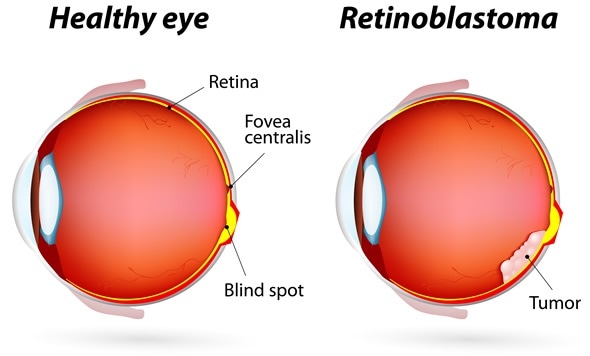A retinoblastoma is a malignant tumor of the retina, occurring most often in young children below 5 years. In one of three cases it is bilateral i.e., affecting both eyes. About 250-350 new cases occur every year in the USA, in children younger than 15 years.

Eye disease. Healthy eye and Retinoblastoma. Image Copyright: Designua / Shutterstock
Understanding Retinoblastoma
Types of Retinoblastoma
Retinoblastomas are classified as intraocular and extraocular, and may also be recurrent or associated with a pinealoma.
Intraocular Retinoblastoma
The tumor is confined to one or both eyes but doesn’t extend beyond the ocular tissue, and no metastases are present.
Extraocular Retinoblastoma
The cancer spreads beyond the eyeball, most often through the optic nerve. The extension may be local or distant.
Trilateral Retinoblastoma
This refers to the presence of a retinoblastoma in both eyes along with a pineal gland tumor of the same type.
Recurrent Retinoblastoma
This refers to the recurrence of the tumor after treatment, either reappearing in the treated eyes, progressing, or appearing in another part of the body.
Symptoms
Leukocoria is the presence of a cat’s eye pupil, or white pupillary reflex, instead of the normal orange-red reflection of the retina. This is often first observed in a photograph of the subject that was taken with a flash.
Other symptoms include:
- Strabismus
- Blurring of vision
- Eye pain, redness or irritation that persists
Genetic Factors
Retinoblastomas may be found in one or both eyes. Bilateral retinoblastomas are always hereditary in origin, while most unilateral retinoblastomas are not. However, if there are multiple retinoblastomas in the same eye, the chances of a hereditary origin are higher.
The importance of this is in the need to screen siblings of children with hereditary tumors. Hereditary tumors are mostly associated with mutations of the RB1 tumor suppressor gene. 40% of retinoblastomas are germinal mutations, with the same mutation being present in every cell of the body.
Treatment
There are many ways to treat a retinoblastoma, depending on how far the disease has extended within the affected eye, the presence of extraocular extension, and whether the tumor is unilateral or bilateral. Early retinoblastomas are often curable.
Different methods have been developed, some aiming at total cure while others focus on sight-preservation.
Enucleation
This surgical procedure removes the entire eye with part of the optic nerve.
Cryotherapy
A cryoprobe is used to freeze tissue within the tumor and thus destroy it.
Photocoagulation
Laser energy is used to heat up the tumor cells and sensitize them to the lethal effects of other treatments, or to destroy the vascular supply and thus inhibit tumor growth through ischemia.
Radiation Therapy
Radiation therapy uses radioactive energy to kill tumor cells. This may be via external beam irradiation using a machine outside the body, or by implantation of a plaque of radioactive material into the eye to be treated (brachytherapy).
Chemotherapy
This approach uses systemic toxins to destroy tumor cells. This may help debulk the tumor by killing off some cells, which is called chemoreduction, and helps to make the tumor easier to treat entirely. The route may be oral, intravenous, intra-arterial (through the central retinal artery, to avoid systemic complications) or intrathecal (into the CSF space).
Follow up
The patient with retinoblastoma may develop a second tumor in another part of the body, such as the bone, skin or soft tissue. For this reason long-term follow up is essential after completion of treatment for a retinoblastoma.
References
Further Reading